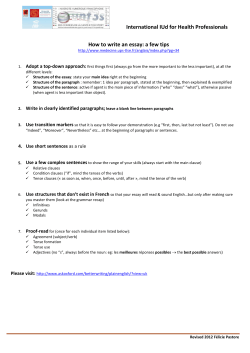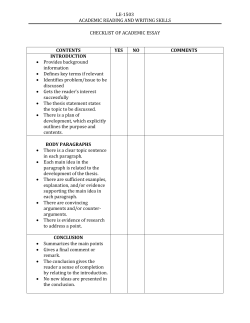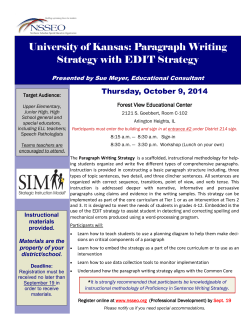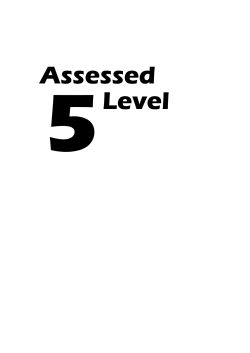
Alignments of ReadiStep Skill Categories and State Standards
Alignments of ReadiStep Skill Categories and State Standards ReadiStep District of Columbia ELA: Learning Standards 2005 Skill Category and Description of Skills Course/ Level Standard Standard ID Determining the Meaning of Words Grade 6 6.LD-V.7. Vocabulary and Concept Development: Determine the meaning of unfamiliar words using knowledge of English language structure, Greek and Latin roots (e.g., annus, aqua), suffixes (e.g., -itis, -osis), and prefixes (e.g., multi-, dis-, anti-, hyper-, syn-). 6.LD-V.7 6.LD-V.8. Vocabulary and Concept Development: Use such clues as definition, example, and restatement to determine the meaning of unfamiliar words and words with multiple meanings in context. 6.LD-V.8 6.LD-V.9. Vocabulary and Concept Development: Determine the meaning of figurative language, including similes, metaphors, personification, and grade-appropriate idioms. 6.LD-V.9 7.LD-V.7. Vocabulary and Concept Development: Use Greek and Latin roots and affixes to determine the meaning of content area vocabulary (e.g., in readings on pioneers of space, determine the meanings of the words astronaut and nautical using knowledge of Greek and Latin roots). 7.LD-V.7 7.LD-V.8. Vocabulary and Concept Development: Use such clues as cause and effect and comparison and contrast to identify the meaning of unfamiliar words and words with multiple meanings in context. 7.LD-V.8 7.LD-V.9. Vocabulary and Concept Development: Use context to confirm meanings of metaphors, similes, and idiomatic language in prose and poetry. 7.LD-V.9 Grade 8 8.LD-V.9. Vocabulary and Concept Development: Monitor text for unknown words or words with novel meanings, using word, sentence, and paragraph clues to determine meaning. 8.LD-V.9 Grade 6 6.IT-A.5. Argument and Persuasive Text: Identify the effect of persuasive strategies and rhetorical techniques (e.g., peer pressure, emotional appeal, exaggeration, repetition) that the author uses to influence readers' thinking or behavior. 6.IT-A.5 Grade 7 7.LT-S.11. Style and Language: Identify and analyze how an author's use of words creates tone and mood. 7.LT-S.11 Grade 8 8.IT-E.2. Expository Text: Explain how an author uses word choice and organization of text to achieve his purposes. 8.IT-E.2 Grade 6 6.IT-E.1. Expository Text: Identify and analyze the author's stated purpose, main ideas, supporting ideas, and supporting evidence. 6.IT-E.1 6.IT-A.5. Argument and Persuasive Text: Identify the effect of persuasive strategies and rhetorical techniques (e.g., peer pressure, emotional appeal, exaggeration, repetition) that the author uses to influence readers' thinking or behavior. 6.IT-A.5 6.IT-A.6. Argument and Persuasive Text: Recognize arguments for and against an issue. 6.IT-A.6 6.LT-C.1. Connections: Analyze the relevance of the setting (e.g., time, place, and situation) to the mood and tone of the text. 6.LT-C.1 7.IT-E.1. Expository Text: Identify the author's purpose(s) in a text when it is not stated. 7.IT-E.1 Understanding of vocabulary and sentence structure — Student determines the meaning of a word in a sentence or a section of text by using context clues, knowledge of the meaning of words, knowledge of root words and affixes, and understanding of how the different parts of a sentence fit together. Grade 7 Author’s Craft Understanding of an author’s use of language and devices — Student understands an author’s purpose in a text. Student recognizes that authors use word choice, literary devices and rhetorical devices to achieve certain effects. Reasoning and Inferencing Use of reasoning and critical thinking to extend or elaborate on a text — Student uses reasoning to connect ideas within a text or across short texts and to draw conclusions about a text or texts. Student makes inferences and recognizes implications in a text. Grade 7 © The College Board 2011. The term standard has been used as a general description. Please refer to your state’s document for the specific name. 1 Alignments of ReadiStep Skill Categories and State Standards ReadiStep District of Columbia ELA: Learning Standards 2005 Skill Category and Description of Skills Course/ Level Grade 8 Grade 6 Organization and Ideas Understanding of ideas and recognition of a text’s organization — Student understands, connects and compares ideas within a text or across short texts. Student understands how a text is organized and recognizes the functions of different parts of a text. . Grade 7 Grade 8 Standard Standard ID 7.IT-A.6. Argument and Persuasive Text: Describe the facts and evidence used to support an argument. 7.IT-A.6 8.IT-E.2. Expository Text: Explain how an author uses word choice and organization of text to achieve his purposes. 8.IT-E.2 8.IT-A.7. Argument and Persuasive Text: Compare and contrast readings on the same topic and explain how authors reach different conclusions, beginning with the author's stated position. 8.IT-A.7 8.LT-F.6. Fiction: Analyze the influence of setting (e.g., time of day, place, historical period, situation) on the problem and resolution. 8.LT-F.6 6.IT-E.1. Expository Text: Identify and analyze the author's stated purpose, main ideas, supporting ideas, and supporting evidence. 6.IT-E.1 6.IT-E.2. Expository Text: Identify and use knowledge of common textual features (paragraphs, topic sentences, concluding sentences, glossary, index, and bibliography). 6.IT-E.2 6.IT-E.3. Expository Text: Identify and use organizational structures in text, including chronological order, comparison and contrast, cause and effect, logical order, and classification schemes. 6.IT-E.3 6.IT-A.6. Argument and Persuasive Text: Recognize arguments for and against an issue. 6.IT-A.6 7.IT-E.2. Expository Text: Identify and use knowledge of common textual features (paragraphs, topic sentences, concluding sentences, glossary, index, bibliography, footnotes, introduction, conclusion). 7.IT-E.2 7.IT-E.3. Expository Text: Apply knowledge of organizational structures of text to aid comprehension, including chronological order, comparison and contrast, cause and effect, logical order, and classification schemes. 7.IT-E.3 7.IT-A.6. Argument and Persuasive Text: Describe the facts and evidence used to support an argument. 7.IT-A.6 8.IT-E.1. Expository Text: Compare (and contrast) the central ideas, problems, or situations from readings on a specific topic selected to reflect a range of viewpoints. 8.IT-E.1 8.IT-E.2. Expository Text: Explain how an author uses word choice and organization of text to achieve his purposes. 8.IT-E.2 8.IT-A.5. Argument and Persuasive Text: Recognize organizational structures and arguments for and against an issue. 8.IT-A.5 8.IT-A.7. Argument and Persuasive Text: Compare and contrast readings on the same topic and explain how authors reach different conclusions, beginning with the author's stated position. 8.IT-A.7 © The College Board 2011. The term standard has been used as a general description. Please refer to your state’s document for the specific name. 2 Alignments of ReadiStep Skill Categories and State Standards ReadiStep District of Columbia ELA: Learning Standards 2005 Skill Category and Description of Skills Course/ Level Standard Standard ID Understanding Literary Elements Grade 6 6.LT-C.1. Connections: Analyze the relevance of the setting (e.g., time, place, and situation) to the mood and tone of the text. 6.LT-C.1 6.LT-T.3. Theme: Apply knowledge that theme, whether stated or implied, refers to the basic meaning of a literary text. 6.LT-T.3 6.LT-F.5. Fiction: Provide examples of all the aspects of the setting (time, place, situation) in a story or novel. 6.LT-F.5 Grade 7 7.LT-F.6. Fiction: Describe a character based on the thoughts, words, and actions of the character, the narrator’s description, and what other characters say and do. 7.LT-F.6 Grade 8 8.LT-F.4. Fiction: Determine how central characters' qualities influence the resolution of the conflict. 8.LT-F.4 8.LT-F.5. Fiction: Interpret a character's traits, emotions, or motivations, and provide supporting evidence from a text. 8.LT-F.5 8.LT-F.6. Fiction: Analyze the influence of setting (e.g., time of day, place, historical period, situation) on the problem and resolution. 8.LT-F.6 6.W-R.5. Revision: Revise writing to improve level of detail and precision of language after determining where to add sensory detail and rearrange text. 6.W-R.5 6.EL.1. Identify eight basic parts of speech (noun, pronoun, verb, adverb, adjective, conjunction, preposition, interjection). 6.EL.1 6.EL.5.a Identify and employ correct usage for present perfect, past perfect, and future perfect tense. 6.EL.5.a 7.W-R.5. Revision: Revise writing to improve organization and word choice after checking the logic of the ideas and the precision of the vocabulary. 7.W-R.5 7.EL.1. Recognize the basic patterns of English sentences (e.g., noun-verb, noun-verb-noun, noun-verb-noun-noun, noun-linking verb-noun). 7.EL.1 7.EL.2. Identify all parts of speech and types and structures of sentences. 7.EL.2 7.EL.4. Use properly placed modifiers and the active voice. 7.EL.4 7.EL.6. Recognize appropriate use of pronoun reference. 7.EL.6 8.W-R.6. Revision: Revise writing for word choice using a variety of references, appropriate organization, consistent point of view, and transitions among paragraphs, passages, and ideas. 8.W-R.6 Use of knowledge of literary elements — Student uses understanding of setting, plot, characterization, theme and narrative perspective (point of view) when analyzing a literary text. Manage Word Choice and Grammatical Relationships Between Words Grade 6 Student knows parts of speech and how they agree in a well-formed sentence (for example, subject-verb-object agreement; pronoun case, reference and agreement; verb form and tense; consistency of voice and person). Student corrects errors in grammatical relationships between and among words in a sentence in order to communicate ideas clearly and concisely. Grade 7 Grade 8 © The College Board 2011. The term standard has been used as a general description. Please refer to your state’s document for the specific name. 3 Alignments of ReadiStep Skill Categories and State Standards ReadiStep District of Columbia ELA: Learning Standards 2005 Skill Category and Description of Skills Manage Grammatical Structures Used to Modify or Compare Student manages modifiers and objects (for example, adjectives and nouns, adverbs and verbs or adjectives, modifying clauses and their objects) to ensure that the modifier-object references are clear, logical and correctly formed. Student corrects errors in modifier-object references, comparative structures and superlative structures in a sentence to communicate ideas clearly and concisely. Course/ Level Grade 6 Grade 7 Grade 8 Manage Phrases and Clauses in a Sentence Grade 6 Student uses well-formed sentence structures (for example, subordinate, coordinate and relative clauses; parallelism; and proper connectives) to indicate relations between and among elements of a sentence. Student recognizes when clauses are formed correctly using appropriate subjects and verb forms (for example, infinitives, gerunds and participles). Student corrects errors in how phrases and clauses are structures in a sentence to communicate ideas clearly and concisely. Grade 7 Grade 8 Standard Standard ID 8.EL.3. Identify and use infinitives and participles and clear pronoun/antecedent reference, as well as properly placed modifiers. 8.EL.3 6.EL.2. Identify and use prepositional phrases, appositives, and independent and dependent clauses to elaborate on ideas. 6.EL.2 6.EL.3. Expand or reduce sentences (adding or deleting modifiers, combining or breaking up sentences). 6.EL.3 7.EL.2. Identify all parts of speech and types and structures of sentences. 7.EL.2 7.EL.4. Use properly placed modifiers and the active voice. 7.EL.4 8.EL.3. Identify and use infinitives and participles and clear pronoun/antecedent reference, as well as properly placed modifiers. 8.EL.3 8.EL.4. Use subordination, coordination, apposition, and other devices to indicate the relationship between ideas clearly. 8.EL.4 6.EL.2. Identify and use prepositional phrases, appositives, and independent and dependent clauses to elaborate on ideas. 6.EL.2 6.EL.3. Expand or reduce sentences (adding or deleting modifiers, combining or breaking up sentences). 6.EL.3 6.EL.4. Identify and use simple and compound sentences. 6.EL.4 6.EL.5.a Identify and employ correct usage for present perfect, past perfect, and future perfect tense. 6.EL.5.a 7.EL.2. Identify all parts of speech and types and structures of sentences. 7.EL.2 7.EL.3. Recognize the makeup and function of prepositional phrases. 7.EL.3 7.EL.5. Identify and use simple, compound, and complex sentences. 7.EL.5 8.EL.2. Distinguish phrases from clauses. 8.EL.2 8.EL.3. Identify and use infinitives and participles and clear pronoun/antecedent reference, as well as properly placed modifiers. 8.EL.3 8.EL.4. Use subordination, coordination, apposition, and other devices to indicate the relationship between ideas clearly. 8.EL.4 8.EL.6. Combine, reorder, and reduce sentences. 8.EL.6 © The College Board 2011. The term standard has been used as a general description. Please refer to your state’s document for the specific name. 4 Alignments of ReadiStep Skill Categories and State Standards ReadiStep District of Columbia ELA: Learning Standards 2005 Skill Category and Description of Skills Course/ Level Standard Standard ID Recognize Correctly Formed Sentences Grade 6 6.EL.2. Identify and use prepositional phrases, appositives, and independent and dependent clauses to elaborate on ideas. 6.EL.2 6.EL.4. Identify and use simple and compound sentences. 6.EL.4 6.EL.5.a Identify and employ correct usage for present perfect, past perfect, and future perfect tense. 6.EL.5a 7.EL.1. Recognize the basic patterns of English sentences (e.g., noun-verb, noun-verb-noun, noun-verb-noun-noun, noun-linking verb-noun). 7.EL.1 7.EL.2. Identify all parts of speech and types and structures of sentences. 7.EL.2 7.EL.4. Use properly placed modifiers and the active voice. 7.EL.4 7.EL.5. Identify and use simple, compound, and complex sentences. 7.EL.5 7.EL.6. Recognize appropriate use of pronoun reference. 7.EL.6 8.EL.3. Identify and use infinitives and participles and clear pronoun/antecedent reference, as well as properly placed modifiers. 8.EL.3 8.EL.4. Use subordination, coordination, apposition, and other devices to indicate the relationship between ideas clearly. 8.EL.4 6.W-R.5. Revision: Revise writing to improve level of detail and precision of language after determining where to add sensory detail and rearrange text. 6.W-R.5 6.EL.3. Expand or reduce sentences (adding or deleting modifiers, combining or breaking up sentences). 6.EL.3 6.EL.5.a Identify and employ correct usage for present perfect, past perfect, and future perfect tense. 6.EL.5.a Grade 7 7.W-R.5. Revision: Revise writing to improve organization and word choice after checking the logic of the ideas and the precision of the vocabulary. 7.W-R.5 Grade 8 8.W-R.6. Revision: Revise writing for word choice using a variety of references, appropriate organization, consistent point of view, and transitions among paragraphs, passages, and ideas. 8.W-R.6 8.EL.6. Combine, reorder, and reduce sentences. 8.EL.6 Student knows parts of speech and understands how they agree in well-formed sentences. Student understands the function of modifying words and phrases and recognizes when they are used correctly. Student understands the relationships between phrases and clauses in well-formed sentences and recognizes when clauses are formed correctly using appropriate subjects and verb forms. Grade 7 Grade 8 Manage Order and Relationships of Sentences and Paragraphs Grade 6 Student recognizes that a clear organization and a smooth progression of ideas improve coherence both within and among the paragraphs in an essay. Student signals the main point or theme, uses effective transitions to signal development, and uses rhetorical conventions to structure ideas. Student corrects errors in organization and development to improve the focus and flow of a paragraph or paragraphs in an essay. © The College Board 2011. The term standard has been used as a general description. Please refer to your state’s document for the specific name. 5
© Copyright 2025









